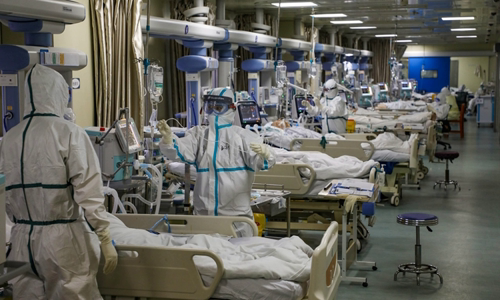China Hubei's change in the calculation of the number of people infected with corona virus may indicate a serious lack of testing equipment, and the scale of the epidemic is unknown.
Recent developments of corona pneumonia (Covid-19) have shown positive signs, as the number of new cases in China reported last week showed that the rate of nCoV spreading seems to be slowing down, meaning that outbreak control efforts have been effective. Some analysts have said that investing in companies with ties to China is safe.

The intensive care unit at a hospital in Wuhan, Hubei Province, China on January 6 Photo: Reuters
However, the situation suddenly turned around after Hubei authorities today reported an additional 14,840 new cases of nCoV, bringing the total number of local cases to 48,206. The number of new infections is 10 times greater than the previous day and is the largest increase in the day since the outbreak. The death toll in the province also increased to 1,310, including 242 new cases.
Hubei Province decided to change the method of calculating the number of cases from 2/13 "to match reports from other provinces." Accordingly, the cases are clinically diagnosed with viral infections will be counted in the number of new cases, instead of just based on the test results as before.
These new infections are those with symptoms consistent with Covid-19, but do not necessarily have positive virus test results. 13,332 patients out of 14,840 newly diagnosed cases.
According to commentator Roni Caryn Rabin of NY Times, these figures show that it is still extremely difficult to grasp the scale and severity of the Covid-19 epidemic in China, especially in Hubei "epicenter". , where thousands of patients have yet to be examined.
Rabin said the change in the way the number of cases in Hubei was calculated might stem from a change in diagnostic standards. Officials are believed to be forced to make this decision because so many people show symptoms of nCoV infection, while medical facilities in Hubei lack the equipment to conduct complex testing.
For now, it seems that people diagnosed with nCoV infection only on the basis of CT scans are counted in the number of cases. This simplification will help more patients receive needed care, local officials said. However, it also highlights the unpredictability of Covid-19, when some experts were "startled" by new data.
"The current situation is very vague," said Dr. William Schaffner, an expert in infectious diseases at Vanderbilt University, USA. According to him, doctors in China probably don't have the chemicals needed to perform complex tests, and not enough technicians.
However, CT scan is considered to be a high-risk method for diagnosing the disease. Patients with seasonal flu may also show signs of pneumonia during a CT scan. "They say this method is just one of the tests, but based on the data, we don't see that," said Dr. Schaffner.
A doctor in Wuhan last week launched a social media campaign calling for the use of CT scans to simplify screening for suspected nCoV-infected patients, helping to speed up the process of hospitalization and treatment instead of waiting for test results.
Peter Rabinowitz, an expert at the University of Washington, USA, said the change in diagnosis could make it harder to track disease. "Their entire adjustment of screening and detection of patients would cause confusion, leading to a change in the size of the epidemic," he said.
The adjustment of diagnostic criteria is not too strange in the scientific world when they realize that the disease has changed. However, this makes the comparison between weeks not much meaningful. "It sounds simple, but it's very important. Exactly what number are you calculating?" Said Dr. Schaffner.
According to Rabin Institute comments, the soaring number of nCoV infections in Hubei is the latest worrying data suggesting that the Covid-19 epidemic will be difficult to control in the near future. In addition, the epidemiological data in China even before the epidemic were not complete. Medical crises such as Covid-19 can fluctuate suddenly and then sharply increase again.
Scientists are also cautious about predicting the peak of Covid-19 for many reasons. Unlike MERS (acute Middle East respiratory syndrome) and SARS (severe acute respiratory syndrome), nCoV appears to spread very easily despite a lower death rate. The rapid spread of disease makes it difficult for health officials to monitor. A series of restrictions on travel in China has made the task of identifying patients complicated, as some people with symptoms may not be able to reach medical facilities.
Despite the difficulties, an accurate grasp of the Covid-19 epidemic situation in China is essential for global safety, World Health Organization (T) director Tedros Adhanom Ghebreyesus noted. With a central role of the world economy, China can easily "sow germs" everywhere.
"Providing an effective response is a huge task for any country," said Christine Kreuder Johnson, professor of epidemiology at the University of California, USA. "We are completely confused about what will happen next in this disease."



 ReinaDESur
ReinaDESur







